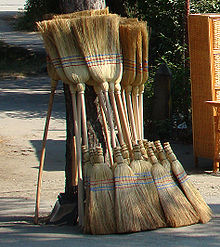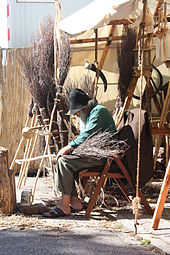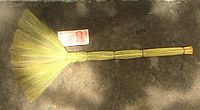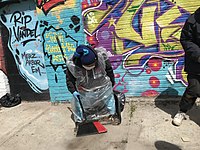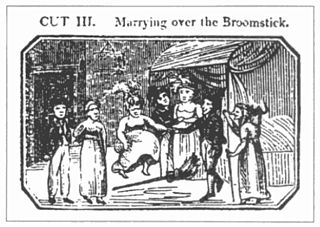
Jumping the broom is a phrase and custom relating to a wedding ceremony in which the couple jumps over a broom. It is most widespread among African Americans and Black Canadians, popularized during the 1970s by the novel and miniseries Roots, and originated in mid-19th-century antebellum slavery in the United States. The custom is also attested in Irish weddings.
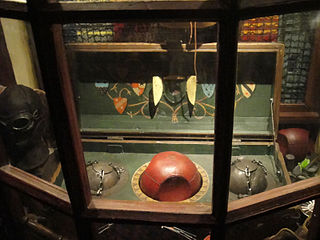
Quidditch is a fictional sport invented by author J. K. Rowling for her fantasy book series Harry Potter. It first appeared in the novel Harry Potter and the Philosopher's Stone (1997). In the series, Quidditch is portrayed as a dangerous but popular sport played by witches and wizards riding flying broomsticks.
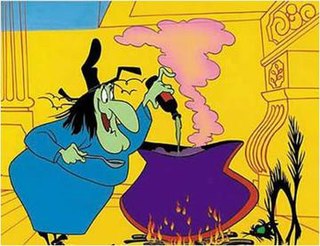
Witch Hazel is an animated cartoon character in the Warner Bros. Looney Tunes and Merrie Melodies series of cartoons and TV shows. Witch Hazel is a fairy tale witch antagonist with green skin, a round figure, bulbous facial features, and a single tooth. The name is a pun on the witch-hazel plant and folk remedies based on it.

A besom is a broom, a household implement used for sweeping. The term is mostly reserved for a traditional broom constructed from a bundle of twigs tied to a stout pole. The twigs used could be broom, heather or similar. The song "Buy Broom Buzzems" from Northern England refers to both types of twig. From the phrase broom besom the more common broom comes. In Scotland, besoms are still occasionally to be found at the edge of forests where they are stacked for use in early response to an outbreak of fire.

Margaret Brainard Hamilton was an American actress and educator. She was best known for her portrayal of the Wicked Witch of the West and her Kansas counterpart Almira Gulch in the 1939 Metro-Goldwyn-Mayer film The Wizard of Oz.

The Worst Witch is a series of children's books written and illustrated by Jill Murphy. The series are primarily about a girl named Mildred Hubble who attends a witch school and fantasy stories, with eight books published. The first, The Worst Witch, was published in 1974 by Allison & Busby, and the most recent, First Prize for the Worst Witch, was published in 2018 by Puffin Books, the current publisher of the series. The books have become some of the most successful titles on the Young Puffin paperback list and have sold more than 5 million copies.
The Wicked Witch of the West is a fictional character who appears in the classic children's novel The Wonderful Wizard of Oz (1900), created by American author L. Frank Baum. In Baum's subsequent Oz novels, it is the Nome King who is the principal villain; the Wicked Witch of the West is rarely even referred to again after her death in the first book.

The Wicked Witch of the East is a fictional character created by American author L. Frank Baum. She is a crucial character but appears only briefly in Baum's classic children's series of Oz novels, most notably The Wonderful Wizard of Oz (1900).
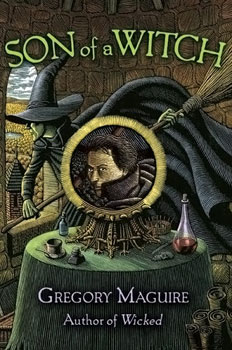
Son of a Witch (2005) is a fantasy novel by American writer Gregory Maguire. The book is Maguire’s fifth revisionist story and the second set in the land of Oz originally conceived by L. Frank Baum. Son of a Witch continues the story after the fall from power of the Wizard of Oz and the death of Elphaba by recounting the life of Elphaba’s son, Liir. The book is dedicated to the cast of the Broadway musical version of Wicked.
A feather duster is a cleaning tool that is typically made from a wooden dowel handle onto which feathers are wound with a wire. The feathers are most often 14 to 32 inches long. Some dusters have a retractable casing instead of a dowel handle and these are typically used by rack-jobbers and truck drivers who need to clean store shelves, and can retract the feathers into the handle to avoid damage.
The fictional universe of British author J. K. Rowling's Harry Potter series of fantasy novels comprises two distinct societies: the wizarding world and the Muggle world. In the novels, the Muggle world is the world inhabited by the non-magical majority, with which the wizarding world exists coextensively, albeit mostly remaining hidden from the non-magical humans. The plot of the series is set in 1990s Britain, but in a veiled and separate shadow society wherein magic is commonly used and practised, and those who can use it live in self-enforced seclusion, hiding their abilities from the rest of the world. The term "wizarding world" refers to the global wizard community that lives hidden in parallel with the Muggle world; the different terms refer to different communities within the same area rather than separate planets or worlds. Any new works taking place in this universe are released under the "J. K. Rowling's Wizarding World" brand.
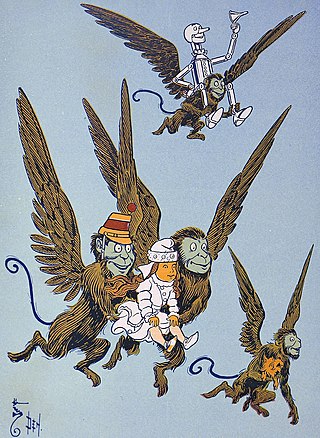
Winged monkeys are fictional characters that first appeared in the 1900 children's novel The Wonderful Wizard of Oz, written by the American author L. Frank Baum. They are described as jungle monkeys with bird-like feathered wings. They are playful, intelligent, and speak English. They are initially under the control of the Wicked Witch of the West, but are later controlled by the protagonist, Dorothy Gale. They lift Dorothy and fly her to two distant locations.

Broom-Stick Bunny is a 1956 Warner Bros. Looney Tunes short directed by Chuck Jones. The short was released on February 25, 1956, and stars Bugs Bunny. The short is notable for being June Foray's first time working with Jones, though she had previously worked in a couple shorts for other directors. She continued to collaborate with him after Warners' closed their animation department. Foray herself would continue to collaborate with Warner Bros. up until her death.
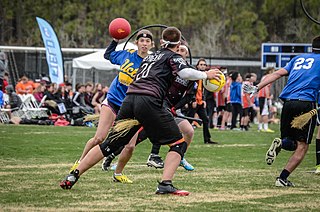
Quidditch, officially known as quadball since 2022, is a team sport that was created in 2005 at Middlebury College in Middlebury, Vermont, United States, and was inspired by the fictional game of the same name in the Harry Potter books by the author J. K. Rowling. Two teams of seven players each, astride broomsticks and opposing each other on a rectangular pitch, compete with the primary objective of passing a ball through the defenders' hoops, while preventing their opponents from passing it through their own hoops. The real-world sport is sometimes referred to as "muggle quidditch" to distinguish it from the fictional game of the books, which involves magical elements such as flying broomsticks and enchanted balls—a muggle in the Harry Potter series being a person without magical abilities. The sport is played around the world.
"Defying Gravity" is the signature song from the musical Wicked, composed by Stephen Schwartz, originally recorded by Idina Menzel and Kristin Chenoweth on November 10, 2003, and released on December 16, 2003. It is mostly a solo sung by the main character of the show, Elphaba, with two small duets at the beginning and in the middle of the song between Elphaba and her friend Glinda, and a chorus part at the end in which the citizens of Oz sing.

The Wizard of Oz is a musical with a book by John Kane, music by Harold Arlen and lyrics by E. Y. Harburg. It has additional background music by Herbert Stothart. It is based on the 1900 novel The Wonderful Wizard of Oz by L. Frank Baum and the 1939 film version written by Noel Langley, Florence Ryerson and Edgar Allan Woolf.

The Wizard of Oz is a 2011 musical based on the 1939 film of the same name in turn based on L. Frank Baum's novel The Wonderful Wizard of Oz, with a book adapted by Andrew Lloyd Webber and Jeremy Sams. The musical uses the Harold Arlen and E. Y. Harburg songs from the film and includes some new songs and additional music by Lloyd Webber and additional lyrics by Tim Rice. It is the third stage musical adaptation of the film following the 1942 version for the St. Louis Municipal Opera and the 1987 version for the Royal Shakespeare Company.

Guardians of Oz is a 2015 animated adventure film, directed by Alberto Mar and executive produced by Jorge Gutierrez. The film was produced by Ánima Estudios, Discreet Arts, and distributed by FilmSharks International. The film is the first English-language and flagship CG production for Ánima Estudios, as well as the studio's biggest production and is described as Mexico's biggest animated production. Mexico's take on the early 20th century Wizard of Oz books by L. Frank Baum, it features an original story and new characters, and was released theatrically on 10 April 2015 in Mexico.
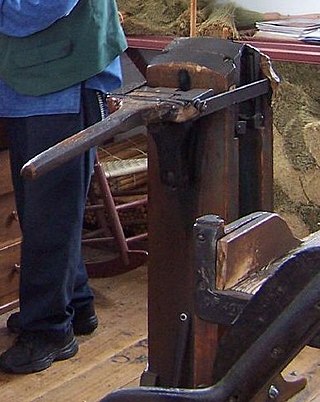
The Shaker broom vise is a specialized production vise that made the normally round broom flat to make it more efficient for cleaning purposes. The Shakers' invention revolutionized the production and form of brooms; in the process greatly expanding an industry in New England.

Professor Minerva McGonagall is a fictional character in J. K. Rowling's Harry Potter series. Professor McGonagall is a professor at Hogwarts School for Witchcraft and Wizardry, the head of Gryffindor House, the professor of Transfiguration, the Deputy Headmistress under Albus Dumbledore and a member of the Order of the Phoenix. Following Lord Voldemort's defeat at the hands of her student Harry Potter and the deaths of Headmasters Albus Dumbledore and Severus Snape, McGonagall takes the position of Headmistress. McGonagall was originally portrayed in the film adaptations by actress Maggie Smith, and later by Fiona Glascott in the Fantastic Beasts prequel films The Crimes of Grindelwald and The Secrets of Dumbledore.
16. "Brooms" (in crypto) are a symbol of good luck around the world. They sweep away bad fortune and protect against evil.
